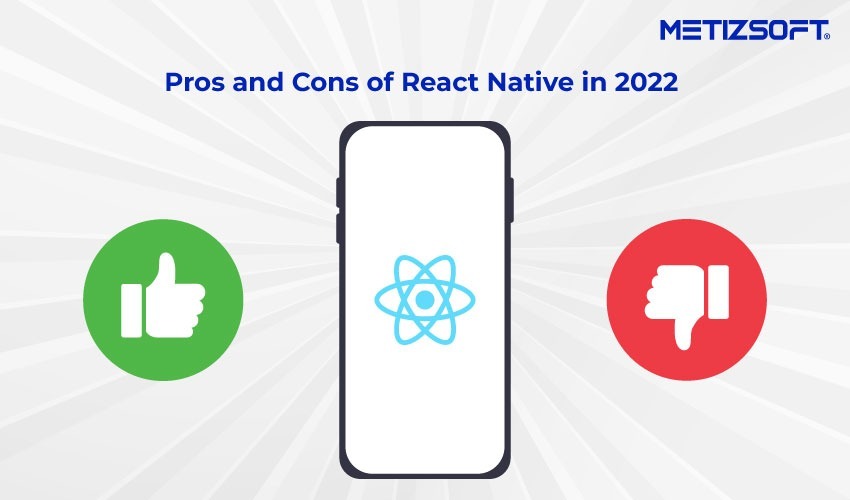
Lately, mobile app development has been multiplying, covering every business category in advance and precisely.
Many enterprises have started to invest more in mobile application development segments by adopting several mobile app options to deliver robust and dynamic solutions to their clients.
Out of many, cross-platform app development has been highly recommended and used as a core mobile app development framework amongst developers worldwide.
And to create such a prolific cross-platform application, most developers prefer React Native as their primary cross-platform framework over many.
Facebook introduced React Native in 2015. Since then, it has been growing immensely due to its simplified components.
But, as the framework continues to evolve, the developer’s community started to differentiate the pros and cons of React Native for better optimization.
We have made a checklist of essential pros and cons of React Native to help you look into its core and find out yourself before concluding anything at all.
Table of Contents
Pros of React Native
So, here is the key highlights of the pros of React Native from a business and app development perspective.
1. Faster Development
The forefront adaptability of React Native as a core native app development framework is its optimal performance in app development.
React Native has numerous ready-to-deploy components that proactively accelerate the app development process.
Also, it has a reusable codebase that is well-compatible in making Android and iOS applications. It means developers don’t have to spend valuable time writing different codebases for the two OS.
Used single-codebase with a different set of APIs and databases.
The single codebase makes bug fixing easy for developers, period!
2. Live & Hot Reloading
React Native is well-known for its live and hot reloading functionality. Let me explain it to clear up your confusion;
Live Reloading is a tool that helps in real-time compiling and reading the file while the developer makes the changes in the code file.
On the other side, Hot Reloading refers to the Hot Module Replacement (HMR) that allows developers to immediately see the aftereffect of the changes made in the code in the app while it’s running.
The crucial factor of Hot Reading is that it allows source code modification, and you don’t need the app recompilation for viewing the source codes.
3. Simplified User Interface
This open-source JavaScript framework offers a simple user interface, making the app quick and responsive, which reduces the loading time.
The React Native UI comprises native components that perfectly fit the codebase and help developers get the sequence right. As a result, developers can create dynamic, user-friendly, and easy-to-navigate UI easily.
4. Third-Party Plugins Support
Like any other framework, React Native, too, lacks some should have components. But that does not mean it can’t be brought or linked up with third parties, and it indeed can.
React Native developers leverage this third-party plugin option precisely to get the job done.
For example, if you plan to add some core features like a world map in your app and can’t find the plugin in its components, you can implement it with the support of a third-party module.
5. Modular Architecture
React Native developers greatly benefit from its modular architecture, as it helps them quickly update the app. They can reuse the modules for the exact web and mobile APIs codes.
It allows them to segregate the modular functions into various interchangeable free blocks known as modules.
6. Extensive Developers Community
As React Native is a JavaScript-based open-source framework, developers worldwide have free access where they can learn and contribute proactively.
It also helps enterprises to leverage the experience of those React Native developers during their app development process.
We all know that React Native is a subordinate of Facebook – the largest social media platform.
It automatically improves community support, which helps better code practice and results.
7. Cost-effective
The code reusability, open-source segments, and the largest community support significantly reduce the project development cost.
You don’t need to employ a large set of React Native teams, as, primarily, one experienced react native developer can help you create a feature-rich cross-platform application.
Cons of React Native
So far, you must have gathered in-detail information about the pros of React Native.
However, as a responsible information provider, we must show you the other side of the coin and give you an update on the cons of React Native in a nutshell.
1. Steep Learning Rope
React Native has rapidly grown as the prime choice for cross-platform development frameworks. But, it’s new and still in beta form.
Your developers need to spend enough time learning about its core features, functionalities, and configuration before starting any project.
Otherwise, they might encounter various issues with package compatibility or debugging tools., which can impact your development process.
2. Longer Initialization time
React Native is a JavaScript-based open-source framework, and we know JavaScript threads take ample time to initialize.
In that case, React Native also takes a lot of time to initialize the runtime. Not only for small devices but also hi-tech gadgets, it was initially furnished devices.
3. Lack of Security
Not in all application development, but you must be extra careful if you build fintech or banking apps using React Native.
The open-source lacks security, which creates considerable gaps in the security robustness.
4. Few Custom Modules
React Native does behold a large spectrum of custom modules from which developers benefit. But there’s still space for reliable and specific custom modules, which either they need to build from scratch or buy from a third party.
Bottom Line
So here is our preferred list of Pros and Cons of React Native, which we have briefly explained for your consideration before your next project.
Concluding the pros and cons, we can only tell you that it is the most cost-effective, time-saving, and valuable framework which can shape your application as per your need.
As far as our perspective goes, we believe that the React Native framework’s future’s as bright as Sun. It will continue its dominance amongst developers’ communities and enterprises in the upcoming days.
To leverage its core components to the fullest, you can prefer to hire React Native developers from a renowned React native development company like Metizsoft at the earliest.
AboutChetan Sheladiya
Related Posts
Table of Contents What is a Mobile App?So let us give you an overview of both frameworks.Now, let’s compare Flutter and React...
What is The Importance of On-Demand Taxi Booking Apps & How Much Does it Cost to Develop?
The development of the cab booking industry is rapidly growing, and its service has become essential across many countries....

